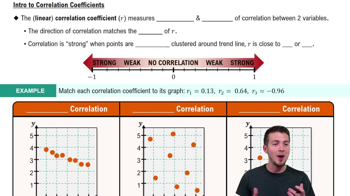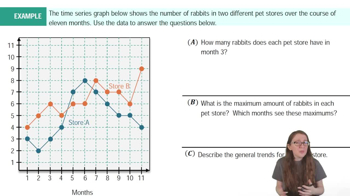Here are the essential concepts you must grasp in order to answer the question correctly.
Linear Correlation Coefficient (r)
The linear correlation coefficient, denoted as r, quantifies the strength and direction of a linear relationship between two variables. Its value ranges from -1 to 1, where 1 indicates a perfect positive correlation, -1 indicates a perfect negative correlation, and 0 indicates no correlation. Understanding r is crucial for interpreting how changes in one variable may relate to changes in another.
Recommended video:
Mean Speed and Time Relationship
In the context of the given data, the mean speed of the cars and the time taken for the trip are two variables that can be analyzed for correlation. Typically, as speed increases, the time taken to complete a trip decreases, suggesting a negative correlation. Analyzing this relationship helps in understanding how these two factors interact in real-world scenarios.
Recommended video:
Time-Series Graphs Example 1
Random Sampling
Random sampling is a technique used to select a subset of individuals from a larger population, ensuring that every individual has an equal chance of being chosen. This method is essential for obtaining unbiased data, which enhances the validity of statistical analyses. In this case, the 50 randomly selected adults provide a representative sample for estimating the correlation between speed and time.
Recommended video:
Sampling Distribution of Sample Proportion






